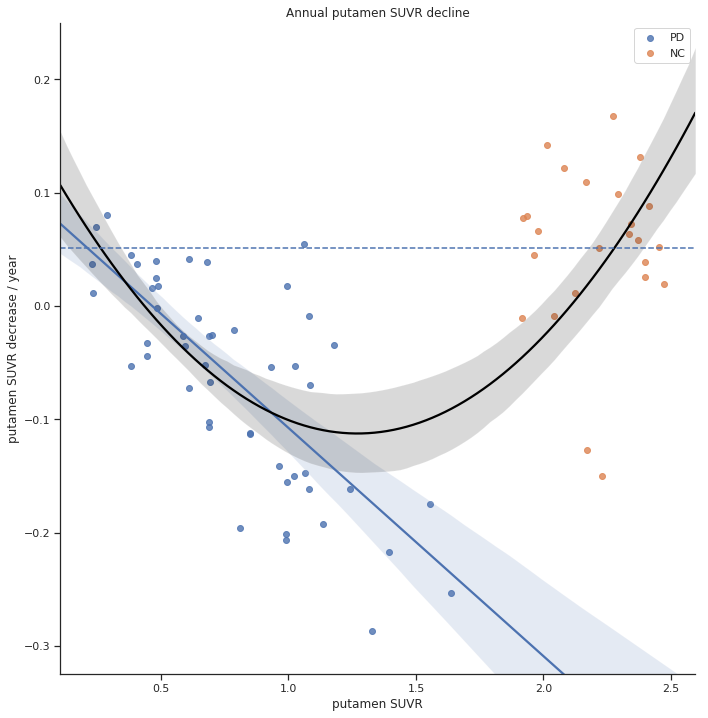Session Information
Date: Tuesday, September 24, 2019
Session Title: Parkinsonisms and Parkinson-Plus
Session Time: 1:45pm-3:15pm
Location: Agora 3 West, Level 3
Objective: To evaluate the progression of nigrostriatal degeneration in participants with Parkinson’s disease (PD) using 18F-AV-133 vesicular monoamine transporter type-2 (VMAT2) PET.
Background: Vesicular monoamine transporter type 2 (VMAT2) is a presynaptic intraneuronal transporter, that provides a reliable marker for nigrostriatal terminal integrity. 18F-AV-133 is a 18F–labelled dihydrotetrabenazine analogue that selectively binds to (VMAT2) and allows for in vivo evaluation of VMAT2 density. We have previously established that 18F-AV-133 VMAT2 PET is a useful tool in improving diagnostic accuracy in clinically uncertain parkinsonian syndrome [1[ and its diagnostic utility remains robust long term [2]. 18F-AV-133 PET offers multiple potential advantages compared to dopamine transporter SPECT, including improved image quality and quantification, reduced tracer administration to scan interval time, reduced scan duration and no requirement for prescan thyroid blockade.
Method: We investigated 27 participants with PD and 12 healthy controls. All participants had an initial 18F-AV-133 PET scan and a second scan 27 +/- 5 months later (range 19 to 42 months). The regional tracer binding of the total putamen, anterior and posterior putamen and caudate was expressed as a ratio to the primary visual cortex to give standard uptake value ratios (SUVR). The annual change in 18F-AV-133 uptake was calculated by the difference in SUVR in the baseline and second scan and divided by the time interval between the two scans.
Results: In the PD cohort, the annual rate of SUVR decline was -0.13 +/- 0.1 in the putamen, (-0.07 +/- 0.11 in the anterior putamen, -0.06 +/- 0.08 in the posterior putamen) and -0.05 +/- 0.13 in the caudate. However, the rate of decline vs baseline SUVR was U shaped when including controls (Figure 1) and linear in PD with rate inversely proportional to the severity of baseline SUVR reduction (Figure 1, r = 0.66, p < 0.001).
Conclusion: 18F-AV-133 VMAT2 PET is a sensitive marker of nigrostriatal degeneration and a useful diagnostic aid but its application to neuroprotection trials is problematic in persons exhibiting PD due to “floor effect” resulting in slowing of decline as the disease advances.
References: 1. Alexander PK, Lie Y, Jones G, et al. Management impact of imaging brain vesicular monoamine transporter type-2 (VMAT2) in clinically uncertain parkinsonian syndrome (CUPS) with 18F-AV133 and PET. J Nuclear Medicine 2017:jnumed. 116.189019. 2. Xu SS, Alexander PK, Lie Y, et al. Diagnostic accuracy of imaging brain vesicular monoamine transporter type 2 (VMAT2) in clinically uncertain parkinsonian syndrome (CUPS): a 3-year follow-up study in community patients. BMJ Open 2018;8(11):e025533.
To cite this abstract in AMA style:
S. Xu, V. Dore, P. Alexander, Y. Lie, S. Bozinovski, R. Mulligan, K. Young, V. Villemagne, C. Rowe. Measuring progression of nigrostriatal degeneration in Parkinson’s disease using 18F-AV-133 vesicular monoamine transporter type-2 (VMAT2) PET [abstract]. Mov Disord. 2019; 34 (suppl 2). https://www.mdsabstracts.org/abstract/measuring-progression-of-nigrostriatal-degeneration-in-parkinsons-disease-using-18f-av-133-vesicular-monoamine-transporter-type-2-vmat2-pet/. Accessed January 7, 2026.« Back to 2019 International Congress
MDS Abstracts - https://www.mdsabstracts.org/abstract/measuring-progression-of-nigrostriatal-degeneration-in-parkinsons-disease-using-18f-av-133-vesicular-monoamine-transporter-type-2-vmat2-pet/

